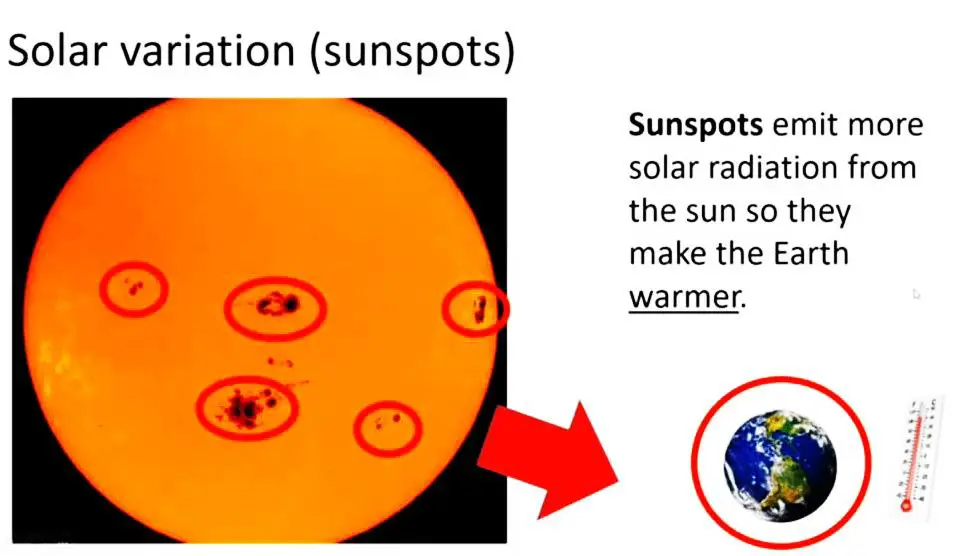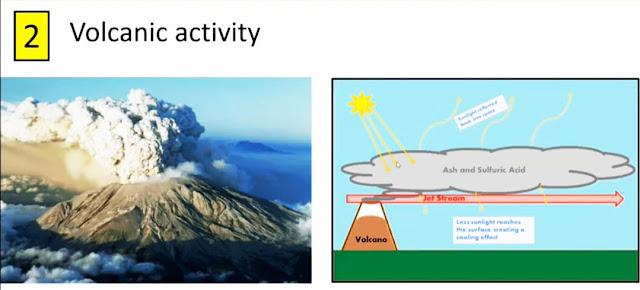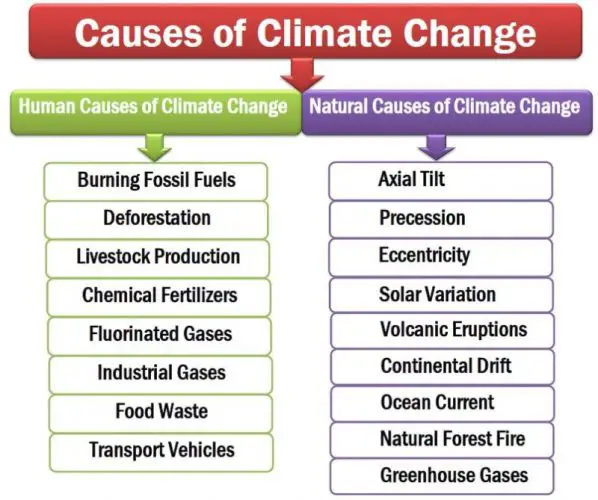This article offers instruction on how to apply for Bangladeshi MRP, digital, and e passport from Malayisa. It also provide information regarding Appointment bdhckl.gov.bd/Entry list/Reissue/Poslaju. Also, B.D. Embassy K.L. Address, Contact Number, Maybank Account, Passport Renew, Passport Check Online, Delivery Poslaju. Bangladesh High Commission Malaysia (বাংলাদেশ হাইকমিশন মালয়েশিয়া পাসপোর্ট ডেলিভারি স্লিপ চেক, ও ট্রাভেল পাস- পাসপোর্ট নাম্বার দিয়ে পাসপোর্ট চেক, পাসপোর্ট এপারমেন্ট).
BDHCKL- Bangladesh High Commission Malaysia
Malaysia and Bangladesh have maintained an excellent bilateral relationship since the independence of the People’s Republic of Bangladesh in 1971. Bangladesh got recognition from Malaysia on 31 January 1972. Bangabandhu Sheikh Mujibur Rahman, the Father of the Nation in Bangladesh, visited Malaysia in 1973 and set the Bangladesh-Malaysia relationship. Around 800,000 Bangladeshi people reside in Malaysia with different visa permits, including students, workers, professionals, etc.
Bangladesh High Commission Malaysia is also known as Bangladesh High Commission Kuala Lumpur. The short form of Bangladesh Bangladesh High Commission Kuala Lumpur is Bdhckl and B.D Embassy.
Many Bangladeshi expatriates work here as workers for local and international companies. Nowadays, the company applies for their worker passport renewal virtually.
Bangladeshi e-Passport Renewal From Malaysia
Bangladeshi people living in Malaysia can apply for e-passport renewal from Kuala Lumpur, Malaysia. Bangladesh High Commission, Kuala Lumpur, Malaysia launched the e-passport service for Bangladeshi students, employees, and expatriates. The applicants can apply through EXPAT Services Kuala Lumpur Sdn Bhd (ESKL) for e-passport renewal.
Why Should We Apply For an E-Passport?
Recently, the Bangladesh High Commission in Malaysia stopped accepting applications for MRP Passports due to technical issues. Therefore, Bangladeshi people in Malaysia must apply for an e-passport.
EXPAT Services Kuala Lumpur Sdn Bhd (ESKL)
Expat Services (Kuala Lumpur) Sdn Bhd is the outsourcing company appointed by the Ministry of Home Affairs and Ministry of Foreign Affairs to complete the e-passport application form online.
Address Expat Services (Kuala Lumpur) Sdn Bhd, Southgate: Commercial Centre, Level 2, Block E, No 2, Jalan Dua Off Jalan Chan Sow Lin-55200. Wilayah Persekutuan, Kuala Lumpur.
Required Documents For e-passport Application
1. Application form should be filled as per National Identity Card (NID) or Online Birth Certificate (BRC English Version).
2. Online verified copy of National Identity Card (NID) / Birth Registration Certificate (BRC) should be submitted.
For minor (less than 18 years) applicants who do not have a National Identity Card (NID), the National Identity Card (NID) number of their father and mother must be mentioned. Copy of National Identity Card (NID) of father and mother and online verified copy should be submitted.
National Identity Card (NID) or Online Birth Registration Certificate (BRC English Version) should be submitted as per the following age-
(A) Online Birth Certificate (BRC English Version) if below 18 years.
(b) National Identity Card (NID) or Online Birth Certificate (BRC English Version) if 18-20 years.
(c) National Identity Card (NID) is required if above 20 years. However, online birth registration certificate (BRC English Version) will be accepted in case of application from Bangladesh mission abroad. In this case, parents' National Identity Card (NID) and online derivation copy have to be submitted.
3.In case of adoption/guardianship, an order issued by the Department of Security Services, Ministry of Home Affairs should be submitted along with the passport application.
4. For all applications below 18 years and above 65 years e-passport will be valid for 35 years and 48 pages. 10. Relevant technical certificates (eg: doctor, engineer, driver etc.) should be uploaded / attached.
Application Process
For identification and biometric purposes, applicants are required to present during passport application submission.
- Must book an appointment to visit the Passport Application Centre. You can visit either www.expatserviceskl.com or contact our help desk.
- Kindly visit the application center on the scheduled day of your appointment and ensure that you have all the necessary documents with you.
- The application form must be completed by a designated officer in the applicant’s presence at the application center.
- Make the relevant payment exclusively at the application center (please obtain the receipt, as it is necessary for passport collection).
- Proceed with the enrollment of your biometric data.
- Retrieve your passport at the nearest post office once the process is complete.
Bangladeshi e-Passport Renewal Fees in Malaysia
| Visa category | Expiration and Government Fees of e-Passport | ESKL and its Service Charge | |||
| Common worker and student | 48 Pages | 5 Year’s | RM 164 | Online Appointment for Application Form Filling and Document Preparation Interview, Bio Enrolment, and Scanning Passport Delivery | RM 32.00 |
| 10 Year’s | RM 273 | ||||
| 64 Pages | 5 Year’s | RM 817 | |||
| 10 Year’s | RM 953 | ||||
| Others | 48 Pages | 5 Year’s | RM 545 | Online Appointment for Application Form Filling and Document Preparation Interview, Bio Enrolment and Scanning Passport Delivery | RM 60.00 |
| 10 Year’s | RM 681 | ||||
| 64 Pages | 5 Year’s | RM 817 | |||
| 10 Year’s | RM 953 | ||||
Bangladesh High Commission Consular New Fees 2025
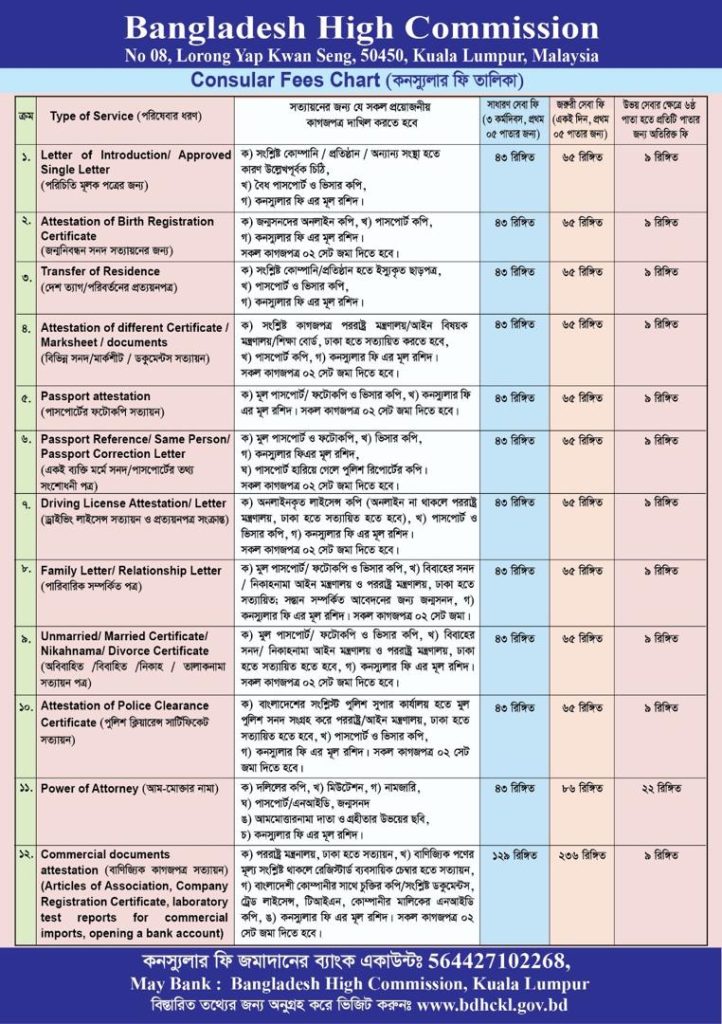
Bangladesh High Commission in Kuala Lumpur is committed to providing the highest level of service to Bangladeshi expatriates living in Malaysia.
So, this article will help the Malaysian people and owners of the company who want to understand how to apply for passport renewal and delivery via Malaysian courier and logistic companies such as Pos Malaysia (Postlaju), J&T Express, Sky Net, and many more.
Bangladesh High Commission Malaysia (BDhckl) Address: (বাংলাদেশ হাইকমিশন কুয়ালালামপুর, মালয়েশিয়া ঠিকানা)
Bangladesh High Commission in Malaysia has two offices in Kuala Lumpur. The main office is at Jalan Sultan Yahya Petra, which provides all services except passport reissue and delivery. It provides services for both Bangladeshis and foreigners. The BDHCKL provides service-related recruitment for Bangladeshi workers.
Address: Bangladesh High Commission, No. 5B & 5C (Lot No. 9 & 10), Jalan Sultan Yahya Petra, 54100 Kuala Lumpur, Malaysia.
Services: Travel Pass, Document attestation, passport and certificate verification letter, marriage certificate verification, and more.
Consular Services: +60326040949
Bdhckl Facebook Page Link– https://www.facebook.com/bdhckl

BDHCK Consultant Contact Number:
Bangladesh High Commission Malaysia Contact Number: (Non-official WhatsApp, IMO & LINE Number). We always discourage paying money for services.
Bangladesh High Commission Malaysia website: https://www.bdhckl.gov.bd
Bangladesh High Commission Malaysia Passport Service Center
BDHCKL Ampang Passport Application Receive and Delivery Centre (বাংলাদেশ হাইকমিশন মালয়েশিয়া পাসপোর্ট আবেদন ও রিচিভ সেন্টার)
Address: 166, Jalan Besar, Pekan Ampang, 68000 Ampang, Selangor, Malaysia.
Services: Passport reissue, delivery, and Travel Pass Application.
Passport Service Centre: +60176014484, 0162747917
Email: mission.kualalumpur@mofa.gov.bd
Bangladesh High Commission Malaysia Bank Account
(বাংলাদেশ এম্বাসী মালয়েশিয়া May Bank অ্যাকাউন্ট নাম্বার)
Account Name: Bangladesh High Commission
May Bank Account: 564427102268
Bangladesh High Commission Malaysia Passport
MRP Passport Renewal Process
BDhckl started the passport renewal system virtually due to the COVID-19 pandemic. Now, applicants can send their documents to the BD embassy via Poslaju and other logistics service providers. So, applicants do not need to come to the Embassy in person to renew their passports.
বাংলাদেশ হাইকমিশন মালয়েশিয়া অনলাইনে পাসপোর্ট আবেদন প্রক্রিয়া
Today, we will show the entire process for passport renewal, from application to delivery. In this regard, we have divided the whole process into three stages. The three stages are as follows:
- Application for Bangladesh passport renewal in Malaysia
- Bangladesh Passport Status Check Online
- Bangladesh Passport Delivery Online
BDhckl Reissue
1. Bangladesh MRP Passport Renewal in Malaysia
Based on the instructions of the Bangladesh High Commission in Kuala Lumpur, Malaysia, we have divided the passport renewal process into four steps.
The four steps of the Bdhckl passport renewal are as follows:
- Passport Application Form Download and Fill up
- Deposit Money to Maybank Account(RM 145/484)
- Do Photocopy Passport Info & Visa Page (Visa page is not mandatory)
- Send all Documents to BDhckl (Ampang Passport Office or Jalan Sultan Yahya Petra) Office.
Step-1 Application Form
Firstly, applicants must download the Bangladesh passport Reissue/Information Alteration/Correction Application Form. You may click the following link to download the passport renewal form.
বাংলাদেশ পাসপোর্ট আবেদন ফর্ম ডাউনলোডঃ Bangladesh Passport Renewal Form- Passport Renewal Form
Additionally, applicants must fill in the application form with their name, passport number, signature, fee amount, branch, receipt number, issue date, expiration date, and so on. Everyone must click on a regular delivery, because the B.D. Embassy Malaysia does not provide express service.
Step-2 Maybank Deposit
Secondly, applicants need to deposit money into the following Maybank account. Applicants must send the original money receipt. However, we suggest keeping a photo on your smartphone and scanning a copy or a photocopy.
Bangladesh Embassy Malaysia May Bank Account & Fees
Account Name: Bangladesh High Commission
|
Passport renewal fees are RM 145 for students and workers.(ছাত্র এবং ওয়ার্কার দের জন্য ১৪৫ রিঙ্গিত)
Passport renewal fees are RM 484 for tourists, professionals, and second homes. The applicants should attach additional documents to pay only RM 145.
Bangladesh embassy has set the R.M. 45 for Travel permits and verification letters for passports, marriage certificates, and more. Bangladesh High Commission, Malaysia, has only one May Bank account; hence, the applicants should deposit money into the account mentioned above.
BDhckl does not accept money via online fund transfer, bank cheque, or ATM transfer.
Bangladesh embassy in Malaysia accepts only the Yellow Cash payment slip. The applicant must check the passport number and name before depositing the money. BDhckl does not take deposit slips if the name and passport number are different from the passport.
For example, follow the instructions mentioned in the figure to learn how to deposit money at Maybank.
(বাংলাদেশ হাইকমিশনে পাসপোর্ট আবেদনের জন্য মে ব্যাংকে রিঙ্গিত জমা দেওয়ার নিয়ম দেখুন নিচের ছবিতে)
Step-3 Compiled 4 Items
Additionally, the applicants should compile the four documents, including the application form, the original Maybank payment receipt, and the passport information & visa page. It is unnecessary to have a valid visa for passport renewal; however, the Embassy suggests attaching an expired visa, even if it is not valid. Your visa permit will indicate your category and whether you need to pay RM 145 or RM 484.
Step-4: Sending Documents To the B.D. Embassy
Finally, the applicants must send their documents to the following address: No. 5B & 5C (Lot No. 9 & 10), Jalan Sultan Yahya Petra, 54100 Kuala Lumpur, Malaysia.
Many applicants send the documents to the Ampang passport receiving and delivery centers. Many of them have been sent to the previous embassy location. Bangladesh High Commission suggests sending all documents to the following address: the B.D. The Embassy in Kuala Lumpur is not accountable for documents lost or delayed in the Courier.
2. Bangladesh Passport Check Online
The online process for checking Bangladesh passport status has three steps. The three steps are as follows:
- Documents Status Check By Poslaju Tracking Code
- Bangladesh Passport Check Online Malaysia
- Bangladesh Passport Status Check by Enrolment ID
1. Documents Status Check By Poslaju Tracking Code
In section one, you have sent your documents via Poslaju and other logistics service providers. Applicants can check the status of their documents by tracking the code. It is a very significant way to ensure whether the Embassy has received your documents.
Gopal, Yadav, and Shiela are responsible people who usually receive the items. For example, items are delivered to Gopal. It is good to see that your documents have reached the correct destination. So, you have to wait several days to get the delivery slip number once the High Commission receives the items.
For example, if you send documents through Poslaju, you can check the status through the following link:
https://www.tracking.my/link/poslaju/poslaju-tracking
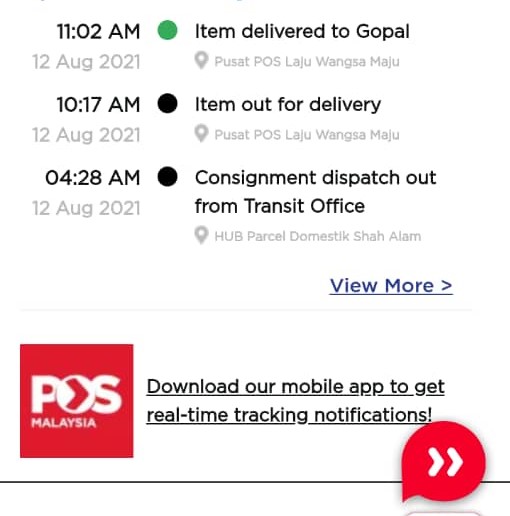
2. Bangladesh Passport Check Online Malaysia
In Malaysia, there are two ways to check the status of a Bangladeshi passport by passport number: the entry list and the delivery slip number.
Appointment.bdhckl.gov.bd/Entry List
The Bangladesh High Commission in Malaysia has launched a new entry list system to verify passport status. In addition to Postlaju, the applicant can check their passport to see whether the Embassy accepts it.
To check the passport in the entry list, applicants need to enter their passport number in the search box and click the search icon to verify whether the Embassy has received their passport. You can also click the following link- https://appointment.bdhckl.gov.bd/entrylist
(পাসপোর্ট Entry List চেক করুন নিচের লিঙ্কে- পাসপোর্ট নাম্বার দিয়ে পাসপোর্ট চেক)
(Reload The Page To Check Again or Another Passport)
Bangladesh Passport Check For Delivery Slip Number
This section represents how to know the delivery slip number. The applicants need to enter their passport number in the box below and click the search button to retrieve the passport delivery slip number. They can also click the following link (appointment.bdhckl.gov.bd/reissue)
Appointment.bdhckl.gov.bd/reissue
নিচের সার্চ বক্সে আপনার পাসপোর্ট নাম্বার দিয়ে সার্চ বাটন ক্লিক করলে পেয়ে যাবেন ডেলিভারি স্লিপ নাম্বার
(পাসপোর্ট ডেলিভারি স্লিপ (MYS ) জানার উপায়: পাসপোর্ট ডেলিভারি স্লিপ চেক) https://appointment.bdhckl.gov.bd/reissue
3. Bangladesh Passport Appointment Poslaju
The Bangladesh High Commission in Malaysia has stopped issuing passports in person; therefore, applying for an online appointment is no longer possible (September 2021). However, applicants can use this to get their passports delivered via Postlaju. B.D. The embassy offers online passport delivery through 41 centers.
BDhckl Poslaju
Applicants can choose any 41 Poslaju centers, including Kuala Lumpur, Penang, Johor Bahru, Cameron Highland, Seremban, Malacca, and more. So, the applicants can get their passports only from these Poslaju centers. The Bd Embassy in Kuala Lumpur advises the applicant to collect the passport from the nearest centers. Now, you can click the following link to apply for your passport to be delivered via Postlaju.
Appointment.bdhckl.gov.bd/Poslaju
(বাংলাদেশ হাইকমিশন কুয়ালালামপুর মালয়েশিয়া থেকে পাসপোর্ট পোস লাজুর মাধ্যমে সংগ্রহের জন্য নিচের লিঙ্কে গিয়ে আবেদন করুন-কুয়ালালাম্পুর, জহরবারু, পেনাং, ক্যমেরুন হাইল্যান্ড)।
পোষ্ট অফিস (POS Malaysia) এর মাধ্যমে পাসপোর্ট সংগ্রহের জন্য
https://appointment.bdhckl.gov.bd/poslaju
Poslaju Passport Tracking
পোস লাজু তে পাসপোর্ট চেক করতে নিচের লিঙ্কে ক্লিক করুন এবং আপনার Barcode নাম্বার দিয়ে চেক করুন।
Bangladesh Passport Status Check by Enrolment ID
This section (Bangladesh passport status check by Enrolment ID) explains how to check the status of a Bangladeshi passport. This instruction is crucial for Bangladeshi people in Malaysia and anyone worldwide. People can check their passport status from Malaysia, Bangladesh, Saudi Arabia, Iraq, Iran, Canada, the USA, the U.K., Europe, and so on.
Applicants can check their passport status only when they get their enrolment ID or delivery slip number. Applicants must click the following link to check their passport status. The most common statuses are pending for scan, pending for A.D., pending for Print, and passport is ready, pending for issuance, etc.
(পাসপোর্ট কি কোথায় এবং কি অবস্থায় আছে সেটি জানার জন্যে নিজের লিংকে ক্লিক করুন এবং চেক করুন ডেলিভারি স্লিপ নাম্বার, জন্ম তারিখ দিয়ে) আপনার ডেলিভারি স্লিপ নাম্বার এবং জন্ম তারিখ কমেন্ট করলে আমরা চেক করে জানিয়ে দিবো।
Bangladesh Passport Online Status Check Link
For example, you need to insert your enrolment ID, date of birth, and Captcha code.
Bdhckl Name Amendment (নাম সংশোধন কিভাবে করবেন)
Recently, many Bangladeshi expatriates have encountered discrepancies in their names, enrollment, and passport numbers. It is an unintentional mistake by the Embassy due to an excessive workload. However, the applicants can apply to amend their names through the Bangladesh embassy amendment page. Click the following link and follow the instructions thoroughly for correction.
BDHCKL Travel Permit
(বাংলাদেশ হাইকমিশন মালয়েশিয়া ট্রাভেল পাস)
|
বাংলাদেশ হাইকমিশন মালয়েশিয়া ট্রাভেল পাসের আবেদন কিভাবে করবেনঃ তিনটি ডকুমেন্ট লাগবেঃ ১। ৪৪ রিঙ্গিত ডিপোজিট শ্লিপ (ডিজিটাল পাসপোর্টের ফটো কপি থাকলে একদিনেই ট্রাভেল পাস পেয়ে যাবেন আর এন আই ডি অথবে জন্ম নিবন্ধনের কাগজ জমা দিলে বাংলাদেশ থেকে ভেরিফিকেশ হয়ে আসলে পাবেন কিন্তু সময় লাগবে) |
Travel permits and special passes are completely different. Malaysia Immigration gives a special pass. Travel Permit (T.P.) is issued by Bangladesh High Commission. Information about travel permits is given below:
Travel Permit
A travel permit is a temporary alternative to the original passport. It is valid for 90 days. BDHCKL provides emergency travel permits for Bangladeshi workers and travelers who wish to return to Bangladesh without a passport.
Conditions for Obtaining a Travel Permit
Bangladeshi people can get it easily if their passports have expired, been lost, or are damaged. The application must be followed by the information of the old, lost, or damaged passport. If the passport is lost, by law, it must be reported to the police along with the application, which serves as proof of loss. Then you will receive a Travel Permit (T.P.) within 1 day.
However, it will take time for those who have never had a passport, as Bangladesh must verify their citizenship. It is illegal to give T.P. without confirmation of citizenship. You will not receive T.P. for submitting incorrect or false information or paper.
How To Apply For a Travel Permit
Along with the application form, three copies of passport-size color photographs, a photocopy of the passport (if any), a visa photocopy (if any), a photocopy of the iCAD (if any), and a paper of Maeji / Iman / B.M., i.e., any one of them, should be submitted as proof. (Passport number is written on Visa, iCAD, and Iman / MEG / BM paper, which can confirm citizenship).
Those who do not have a passport must submit it along with a letter from the UNO or the Deputy Commissioner of their Upazila. This is a way to ensure citizenship for those without a passport. The applicant’s family must apply to the UNO office to expedite the process. UNO will then verify and email the citizenship information to the High Commission at ss.lab.kl@gmail.com. As a result, the High Commission will give TP. Remember that T.P. cannot be offered without confirmation of citizenship.
BDHCKL Travel Permit Application Fee
It is 44 Ringgit (R.M. 44) Bank Draft (Yellow color), Maybank Account No. 564427102268 to be deposited at any branch counter and take a yellow slip. The applicants need to submit the yellow receipt. However, electronic transfers and cash are not accepted.
Address to Apply
Passport Service Center, 16 Jalan Besar, Ampang (next to Ampang LRT), Kuala Lumpur, Malaysia. (166 Jalan Besar Ampang, Kuala Lumpur, Malaysia).
That means you must submit the following: 3 color photographs, a photocopy of your passport or Visa, and a yellow bank slip for the fee deposit.
Submission time: 9 am to 12 pm.
Delivery: 4 – 5 pm.
On behalf of Newsmoor.com, we request all Bangladeshi expatriates in Malaysia to follow social etiquette and prevent the causes of climate change. Many Bangladeshi expatriates want to get their children in Malaysian international school. You can check the following link to know Brighton International School Fees in Malaysia.
| আপনি যদি ইংরেজি বুঝতে না পারেন তাহলে- পাসপোর্ট ডেলিভারি স্লিপ নাম্বার পেতে ও পাসপোর্ট ডেলিভারির জন্য Appointment নিতে আমাদের পোস্টের নিচে আপনার নাম এবং পাসপোর্ট নাম্বার দিয়ে কমেন্ট করুন। আমরা আপনার কমেন্টের নিচে সব জানিয়ে দিবো।
নিজের কাজ নিজে করতে শিখুন, প্রয়োজনে আপনার পরিবার ও আশে পাশের মানুষের কাছ থেকে সহযোগিতা নিন। কোন অপরিচিত ব্যক্তির কাছে টাকার বিনিময়ে সাহায্য নেওয়া থেকে বিরত থাকুন। এগুলোর বাইরে কোন তথ্য জানার থাকলে কমেন্ট করুন আমাদের টিম সহযোগিতা করবে করবে শুধুমাত্র তথ্য দিয়ে। |

